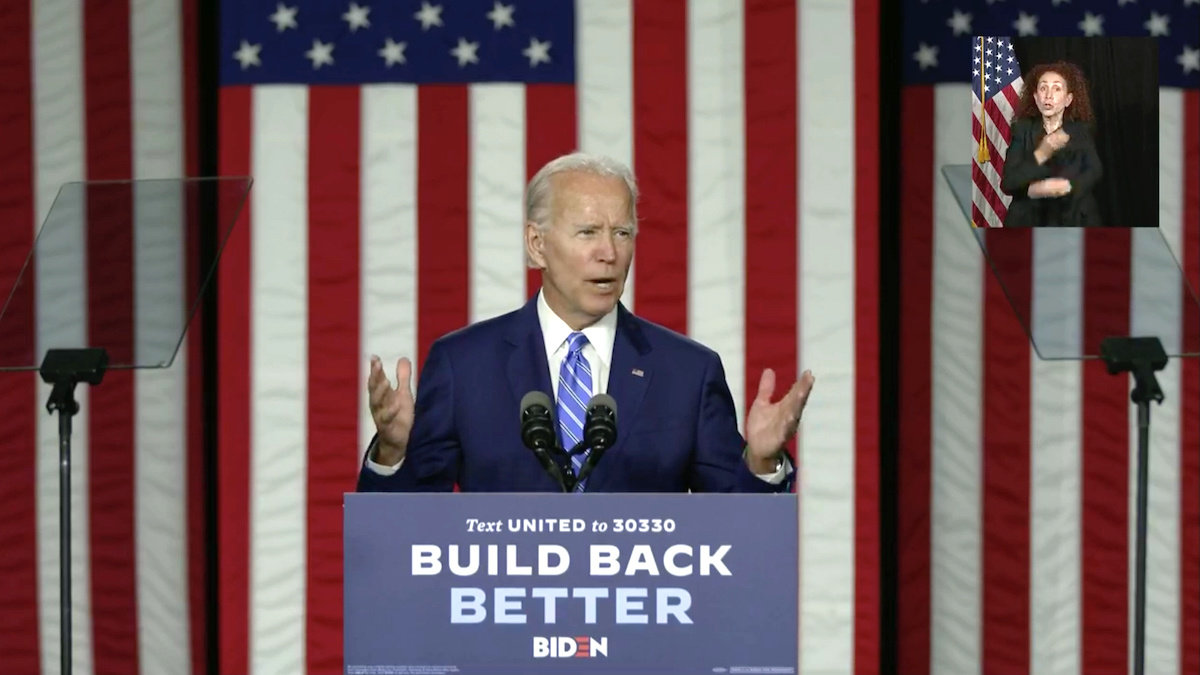

Democratic Presidential candidate Joe Biden speaks at a "Build Back Better" Clean Energy event on July 14, 2020 at the Chase Center in Wilmington, Delaware. Joe Biden / Facebook
Presidential hopeful Joe Biden announced a $2 trillion plan Tuesday to boost American investment in clean energy and infrastructure.
His plan would spend the money over the next four years to boost the transportation, electricity and building sectors’ clean energy profiles. It is also part of a plan to create new economic opportunities, improve the nation’s aging infrastructure, and to combat the climate crisis, as The New York Times reported.
Biden’s sweeping proposals would put an end to all greenhouse gas emissions spewed by U.S. power plants by 2035, arguing that large-scale dramatic moves are necessary to tackle the impending threat of the climate crisis and to revive the economy after the coronavirus pandemic, as The Associated Press reported. It would also ban fracking on public lands.
Speaking near his home in Wilmington, Delaware, Biden also sought to reframe the discussion around the climate crisis, moving it away from a moral imperative and toward an economic one, dismissing Trump‘s and the Republicans’ arguments that investments in green energy would cost jobs. Biden looked to play up how many jobs clean energy creates.
“When Donald Trump thinks about climate change, the only word he can muster is ‘hoax,'” Biden told reporters, The Associated Press reported. “When I think about climate change, what I think of is jobs.”
Biden’s climate initiative calls to chart the U.S. on “an irreversible path” to net-zero carbon emissions by 2050. In addition to achieving a carbon-free power grid by 2035, Biden’s plan calls for upgrades to 4 million buildings and to weatherize 2 million homes over four years to increase energy efficiency, as NPR reported. Homeowners would be given cash rebates to upgrade home appliances and install more efficient windows. Car owners would receive rebates to swap their old, less efficient cars for newer ones that release fewer pollutants, according to The Washington Post.
The proposal, Biden’s campaign said, would aim to shift major cities towards increased use of public transportation and “create millions of good, union jobs rebuilding America’s crumbling infrastructure,” according to NPR.
“We’re not just going to tinker around the edges,” Biden said his speech. “We’re going to make historic investments and seize the opportunity and meet this moment in history.”
Environmentalists and liberals quickly praised the climate initiative as a step forward in the climate effort. Predictably, Republicans quickly denounced it as an unwieldy plan that would raise energy costs, as The Washington Post reported.
The new goals align Biden more closely with three primary opponents: Vermont Senator Bernie Sanders, Massachusetts Senator Elizabeth Warren and Washington Governor Jay Inslee. They follow the recommendations of a unity task force of Sanders and Biden supporters that was co-chaired by New York Congresswoman Alexandria Ocasio-Cortez, who co-sponsored the Green New Deal, according to The Guardian.
“This is not a status quo plan,” said Inslee, as The New York Times reported. “It is comprehensive. This is not some sort of, ‘Let me just throw a bone to those who care about climate change.'”
Inslee called the proposal “visionary.”
Gina McCarthy, the former U.S. Environmental Protection Agency administrator who is now president of the Natural Resources Defense Council Action Fund, told The Guardian that the plan was “by a long shot – the most ambitious we have ever seen from any president in our nation’s history.”
In the proposal, Biden also linked environmental advocacy with racial justice, noting that pollution and other toxins disproportionately affect communities of color. His plan calls for establishing an office of environmental and climate justice within the Justice Department and developing a broad set of tools to address how “environmental policy decisions of the past have failed communities of color,” according to The New York Times.
Varshini Prakash, co-founder of the youth-led Sunrise Movement, said, as The Guardian reported, that Biden’s plan responds to many of the group’s previous criticisms by “dramatically increasing the scale and urgency of investments, filling in details on how he’d achieve environmental justice and create good union jobs, and promising immediate action — on day 1, in his first 100 days, in his first term, in the next decade — not just some far off goals.”
- Green New Deal Champion AOC Will Serve on Biden Climate Panel ...
- Biden-Sanders Unity Task Forces Unveil Improved Climate Policy ...
- How Joe Biden's Climate Plan Compares to the Green New Deal - EcoWatch
- Climate Campaigners Mobilize for Election Nationwide, Vowing to 'Crush Trump' - EcoWatch
- Biden Can Leverage Larger Trends to Make Climate Progress
- UCS Offers Science Advice for Biden Administration - EcoWatch
- Biden Plans to Fight Climate Change in a New Way
- The Rebuilding Years Begin Now - EcoWatch
- Democrats Unveil 'Build Green' Infrastructure and Jobs Act
- Biden to Unveil Major Infrastructure and Climate Plan
- Biden Plans to Cut U.S. Climate Pollution in Half by 2030

 233k
233k  41k
41k  Subscribe
Subscribe 